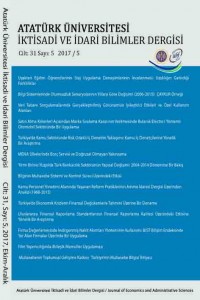Abstract
Önceleri salon gösterimi sona erdikten sonra bir filmin toplam yaşam boyu
gelirlerinin neredeyse tümü gerçekleşirken, gelişen teknoloji ve yeni dağıtım
kanallarının ortaya çıkmasıyla, sinema filmlerinin gelir getirme süreci ve
süresi uzamıştır. Film gelirlerinin çeşitlenmesi ve zamana yayılması muhasebe
bilimi açısından Muhasebenin Genel Kabul Görmüş İlkeleri’nden olan “dönemsel
hasılat-maliyet eşleştirme” ilkesi konusunda zorluklar doğurmaktadır. Filmler
yaşamları boyunca bir gelir akışı sağlama potansiyeli taşımasından dolayı diğer
ürünlerden daha farklı uygulamalara ihtiyaç duymaktadırlar. Bu çalışmada öncelikle
sinema filmleri için amortisman uygulaması Ülkemizde ve A.B.D.’de uygulandığı
şekliyle ele alınmaktadır. Daha sonra sinema filmlerinin gelirlerinin ortaya
çıkışındaki örüntü ile daha uyumlu olduğunu düşündüğümüz “birleşik mamuller”
yaklaşımı sinema filmleri açısından tartışılmakta ve bu yaklaşıma uygun bir amortisman
uygulaması sunulmaktadır.
Keywords
References
- American Institute of Certified Public Accountants -AICPA Statement of Position-SOP00-2
- Allen, R. (1999), “Home alone together: Hollywood and the “family film””, M. Stokes and R. Maltby (der), Identifying Hollywood Audiences: Cultural Identity and the Movies, London: British Film Institute.
- Ferrari M. J. ve Rudd, A. (2008) “Investing in movies”, Journal of Asset Management, 9, ss. 22–40.
- Holson, L. ve Lyman, R. (2002) “In Warner Brothers’ strategy, a movie is now a product line”, New York Times, 11 February.
- Lehmann, Donald R. ve Charles B. Weinberg. (2000) “Sales via Sequential Distribution Channels: An Application to Movie Audiences,” Journal of Marketing, 64(3), ss. 13–33.
- Maltby, R. (1998), “Nobody knows anything: post-classical historiography and consolidated entertainment”, S. Neale ve M. Smith (der), Contemporary Hollywood Cinema, London, Routledge.
- Peker A. (1988), Modern Yönetim Muhasebesi, Dördüncü Baskı, İ.Ü. Muhasebe Enstitüsü, İstanbul.
- Singleton, R. S. (1997), Film Scheduling, İkinci Baskı, Lone Eagle, Los Angeles, CA.
- Vogel H.L. (2007), Entertainment Industry Economics: A Guide for Financial Analysis, Yedinci Baskı, Cambridge University Press.
- Wasko J. (2003), How Hollywood Works, Thousand Oaks, CA: Sage.
- Weinberg, C. B. (2005), “Profits out of the picture: Research issues and revenue sources beyond the North American box office”, C. C. Moul, (der), A Concise Handbook of Movie Industry Economics, Cambridge University Press, New York.
- Young, S.M., Gong J.J., Van der Stede, W.A. (2009), “Value Creation and the Possibilities for Management Accounting Research in the Entertainment Sector: the United States Motion Picture Industry”, C.S. Chapman, A.G. Hopwood ve M.D. Shields, (der), Handbook of Management Accounting Research Vol.3, Elsevier, Oxford, UK.
Abstract
References
- American Institute of Certified Public Accountants -AICPA Statement of Position-SOP00-2
- Allen, R. (1999), “Home alone together: Hollywood and the “family film””, M. Stokes and R. Maltby (der), Identifying Hollywood Audiences: Cultural Identity and the Movies, London: British Film Institute.
- Ferrari M. J. ve Rudd, A. (2008) “Investing in movies”, Journal of Asset Management, 9, ss. 22–40.
- Holson, L. ve Lyman, R. (2002) “In Warner Brothers’ strategy, a movie is now a product line”, New York Times, 11 February.
- Lehmann, Donald R. ve Charles B. Weinberg. (2000) “Sales via Sequential Distribution Channels: An Application to Movie Audiences,” Journal of Marketing, 64(3), ss. 13–33.
- Maltby, R. (1998), “Nobody knows anything: post-classical historiography and consolidated entertainment”, S. Neale ve M. Smith (der), Contemporary Hollywood Cinema, London, Routledge.
- Peker A. (1988), Modern Yönetim Muhasebesi, Dördüncü Baskı, İ.Ü. Muhasebe Enstitüsü, İstanbul.
- Singleton, R. S. (1997), Film Scheduling, İkinci Baskı, Lone Eagle, Los Angeles, CA.
- Vogel H.L. (2007), Entertainment Industry Economics: A Guide for Financial Analysis, Yedinci Baskı, Cambridge University Press.
- Wasko J. (2003), How Hollywood Works, Thousand Oaks, CA: Sage.
- Weinberg, C. B. (2005), “Profits out of the picture: Research issues and revenue sources beyond the North American box office”, C. C. Moul, (der), A Concise Handbook of Movie Industry Economics, Cambridge University Press, New York.
- Young, S.M., Gong J.J., Van der Stede, W.A. (2009), “Value Creation and the Possibilities for Management Accounting Research in the Entertainment Sector: the United States Motion Picture Industry”, C.S. Chapman, A.G. Hopwood ve M.D. Shields, (der), Handbook of Management Accounting Research Vol.3, Elsevier, Oxford, UK.
Details
| Journal Section | Makaleler |
|---|---|
| Authors | |
| Publication Date | October 17, 2017 |
| Published in Issue | Year 2017 Volume: 31 Issue: 5 |





